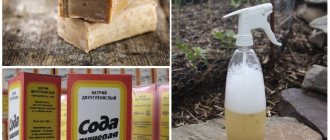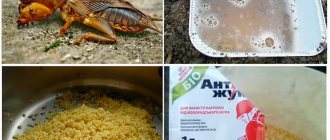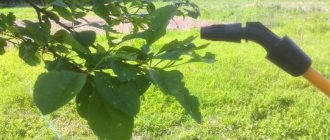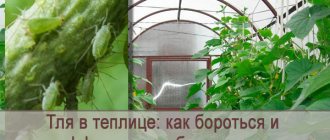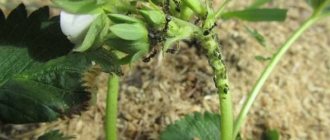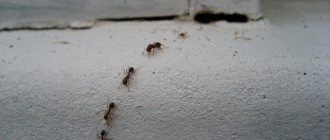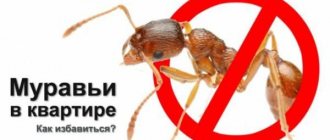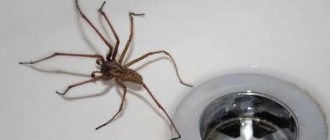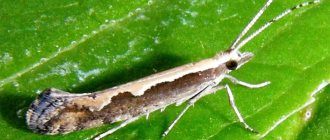Aphids can have a detrimental effect on a wide variety of plants, trees and shrubs; the main harm they cause to them is as follows:
- Sucking liquids from plants, which leads to their gradual withering.
- Irreversible deformation of foliage and parts of shoots.
- Spread of various fungal diseases.
- Deterioration of the general condition of cultivated crops.
- Reduced yield.
- Weakening of plants, which can lead to subsequent death in winter.
Ways to combat aphids
Insecticides
The first way to combat aphids, which will be considered, is the use of special toxic substances, since this technique is the most effective, gives a guaranteed result and provides protection against this type of pest.
All types of modern insecticides designed to combat aphids can be divided into two types of preparations:
- Contact agents that infect insects upon contact or entry into the digestive or respiratory system.
- Systemic agents that are absorbed into plants, infecting aphids, which begin to eat them.
To achieve a positive result, insecticides must be correctly selected; below is a brief overview of the most effective options:
- "Aktara" is a moderately dangerous biological insecticide that is always popular among many gardeners and flower growers due to its complex effect on different types of insects. The drug can not only destroy aphids, but also provide reliable protection against various types of mites, moths and beetles. It is not recommended to use in the immediate vicinity of apiaries, as it poses a fatal threat to bees. Available in the form of an emulsion, which must be diluted with water; complete destruction of pests usually occurs within 2-3 days. You can purchase the product at a price of 20-25 rubles per ampoule, the volume of which is 4 ml. An analogue of this insecticide is the drug “Agravertin”.
- Spark "Double Effect" is an insecticide that affects aphids through direct contact or ingestion. The main active ingredients included in the composition are cypermethrin and permethrin. These are very common substances that have a detrimental effect on most types of insects, so treated plants receive comprehensive protection. The drug causes a number of disruptions in the central nervous system of pests, which consistently lead to paralysis, the inability to perform basic actions to maintain life, and death. This product is produced in the form of tablets for dilution in water; the cost of one package is about 40 rubles.
- "Commander" is a systemic insecticide that can be used for soil treatment or spraying of affected trees and plants. The main active ingredient is imidacloprid, a common and effective toxic substance that is characterized by a high level of toxicity for many insects. “Commander” is produced in the form of a concentrate intended for subsequent dilution in water. Provides protection against the reappearance of insects for 1-1.5 months after treatment; it is dangerous for bees, therefore it is not allowed to use the insecticide near apiaries. The approximate cost is about 50-70 rubles per 10 ml ampoule.
- "Fitoverm" is an insecticide of biological origin, the effect is achieved due to the special properties of the soil fungus, on the basis of which the drug acts. The product can be used both for treating indoor plants and for use in the agricultural industry. “Fitoverm” is capable of destroying not only aphids, but also various types of mites, in which it first causes paralysis and then death. The approximate price of a 50 ml bottle is 170 rubles.
- "Fufanon" is an insecticide whose composition is based on various organic phosphorus compounds; it is one of the main analogues of "Karbofos". This drug can be used against most flying and crawling pests. You can buy one 6.5 ml ampoule for 30 rubles; it will yield about 5-6 liters of active substance. However, it is not recommended to treat fruit crops less than 20 days before harvest.
- "Tanrek" is a well-known insecticide, the main active ingredient of which is imidacloprid. It allows not only to effectively destroy aphids, but also provides high-quality protection against the reappearance of insects. Its duration can range from several weeks to a month, depending on the amount of precipitation. The cost of a 1.5 ml ampoule is about 30 rubles.
Folk remedies
There are also a number of folk remedies that allow you to resist aphids; many of them have not yet lost their popularity and are actively used by gardeners.
Some of the options for such control of these pests are discussed below:
- Prepare a container with 10 liters of ordinary water, in which you need to dilute about 300 grams. laundry soap. In some cases, the use of liquid soap is allowed, but then its volume will need to be halved. The resulting solution is used to treat the affected plants.
- Grate about 100 gr. tar soap, which is diluted in 10 liters of water to prepare a solution that is used to treat affected crops.
- Add about 300 grams of wood ash to a container with 10 liters of water, bring the liquid to a boil and maintain it in this form for about half an hour. To increase the effectiveness of the product, it is recommended to add a small amount of soap to it immediately before treatment.
- About 200 grams of garlic must be crushed as much as possible so that it takes the form of a pulp, which is mixed with a liter of plain water. This mixture must be placed in a dark place and left for 4-5 days. After this, from every 25 ml of infusion you can get about 10 liters of the active treatment agent, but be sure to follow the mentioned proportions so as not to cause burns to the plants.
- Approximately 400 grams of horse sorrel roots are poured with water, the mixture is brought to a boil. After this, it needs to be allowed to cool and in just three hours the product will be ready for use against aphids.
- Take 100 grams of peels from any citrus fruit and soak in a liter of warm, but not hot water. The product should sit in a dark place for three days, after which it can be used to treat any plants.
- Finely chop a kilogram of potato tops, but to prepare the product, they must be completely healthy and not susceptible to any pests. The tops are filled with 10 liters of water, after which the liquid settles for three hours. For cooking, you can also use dried potato tops, but in this case their quantity is reduced by 1.5-2 times.
- Take 200 grams of tobacco leaves and pour 5 liters of water, then let it sit for 3-4 days . After the specified period has expired, add another 5 liters of water, after which the product will need to be strained to get rid of unnecessary grounds remaining from the used foliage.
other methods
There are several other alternative methods to get rid of aphids, some of them are given below:
- Mechanical methods, which involve destroying insects by hand when detected or washing them off plants with water from a hose. These options are less effective because they only remove detected individuals and do not provide any protection against re-emergence.
- Planting nettles or herbs in the garden. This attracts the attention of many birds whose diet includes aphids, as well as beneficial insects, such as ladybugs, which are natural enemies of aphids.
- At the moment, the larvae of many beneficial insects, such as lacewings, can be purchased in stores. They are released in the garden, after which they grow into adults and begin to reproduce. This method can significantly reduce the pest population, although in most cases their number is not enough to completely destroy large colonies.
- Growing Dalmatian chamomile, garlic or onions can repel aphids from a certain area, since this insect does not tolerate these plant species.
Common mistakes
Let's look at the most common mistakes that gardeners make when fighting pests:
- Treatment during flowering leads to the death of bees.
- Treatment on the eve of harvest. You need to finish spraying with all insecticides within 2 weeks to avoid poisoning.
- No preventative work is carried out. Preventing the appearance of a parasite is much easier than getting rid of it later.
- One-time processing. Most likely, a single spray will not kill all the aphids. Usually 2-3 treatments with drugs of different effects help.
- The concentration of the active substance is exceeded. It is necessary to strictly follow the recommendations of the insecticide manufacturer so as not to harm the plant.
- Processing is carried out only on the upper part of the sheet plate. During spraying, the leaves need to be unfolded, the branches and the underside of the leaf blades must be treated.
Features of deliverance in the garden
Below are some measures that can help get rid of aphids in the garden:
- Distinguishing between different types of plants. You can plant options that are attractive to aphids at a considerable distance from those crops that require additional protection from pests. The presence of begonias, nasturtiums or soporific poppy on the site will most likely divert the attention of these insects from other plants. Of the trees, pests prefer to settle on viburnum or linden; if the majority of the population is concentrated on these species, then it will be much easier to find and destroy it.
- Sparrows, tits, kinglets, robins and some other breeds of small birds very often hunt aphids, since they are ideal food for chicks. If there are large populations, birds themselves can pay attention to the area and help in destroying pests, but sometimes they need to be additionally attracted, for example, by installing feeders. However, it must be taken into account that many of them feed on tree fruits, so they can both help and harm.
- Fertilizers, especially the nitrogen type, should be used extremely carefully, since feeding plants with them can lead to a significant spread of aphids, whose attention will be attracted by the abundance of young and fresh greenery.
What does the pest look like?
Aphids are small insects (no more than 7 mm). It has an oval or teardrop shape. The mouth is presented in the form of a proboscis, with which it pierces the tissues of the plant and sucks out the juices from them. It comes in white, green and black. Black aphids are more common in gardens.
ON A NOTE. There are several thousand species of aphids. Interestingly, aphids are a kind of pet for ants. They milk her like people milk cows.
The danger of aphids is that they feed on tree sap, disrupting the natural processes of sap flow. As a result, some of the plant's shoots do not receive proper nutrition. The activity of aphids also affects the fruits of fruit trees.
Features of getting rid of indoor plants
Aphids are found not only in gardens or summer cottages; often, plants grown at home also become targets for their attacks.
In this case, the process of getting rid of these pests will have a number of individual characteristics, which are described below:
- Often the main means of control is to treat the leaves with soapy water or any type of vegetable oil. This technique does not provide any protection, but allows you to effectively get rid of existing individuals, since the liquid with the addition of these components acquires a viscous structure, envelops the bodies of insects and disrupts the respiratory processes in their body.
- Treatment with alcohol also shows good results, but only the pure medical variety is suitable for this procedure. Such alcohol evaporates very quickly, and it is virtually impossible to cause burns. However, this practice is not recommended for plants with very sensitive and thin foliage.
- In most cases, all types of insecticides that are used against aphids and in the garden are suitable; Aktara is the most popular. This is often the most effective option for exterminating insects, which will additionally create protection against their reappearance.
What are the dangers of chemical treatment?
Despite all their effectiveness, chemicals have several significant disadvantages that make their use dangerous. Let's consider the most significant of them.
- Poisoning. When working with poisons, you can get minor poisoning. This is especially true for those summer residents who neglect protective equipment.
- Harm to plants. Incorrect dosage may cause chemical burns.
- Nitrates in fruits. Do not get overly involved in treating with pesticides. Some of them, when decomposed, leave nitrates in the fruits.
- In addition, treatment with chemicals during flowering can cause the death of bees. Most poisons are non-selective, meaning they are dangerous to all insects, beneficial and pests. Treatment with such compounds during periods of abundant flowering leads to damage to all agriculture, and especially to beekeeping.
Signs of aphid damage to plants
As already mentioned, aphids are very small in size and prefer to be on the back side of leaves, so it is not always possible to notice these insects in a timely manner.
However, there are a number of signs that indicate their presence:
- The presence of small white waste, which is old skin shed by aphids.
- The presence of sticky liquid on leaves or buds is a specific secretion secreted by pests.
- Lack of fruit development or opening of existing buds.
- Underdeveloped foliage, they have a poor appearance and curl inward.
What types are there
This pest can be easily identified by these signs:
- Soft and translucent body without chitinous cover;
- The color of the insect completely depends on the plant on which it parasitizes, so there are black, green or white shades;
- The size does not exceed 2 mm;
- Body shape directly depends on the type of insect;
- The body of each insect is decorated with soft short fluff, and minor asymmetrical tubercles perfectly complement the appearance of each individual;
- Some insects have wings;
- Due to the presence of thin and long legs, aphids can crawl or jump, and the organs of touch are small antennae;
- Often individuals do not have distinct sexual characteristics, but there are some specimens that have received the gene responsible for such a mutation. Thanks to it, it is possible to accurately determine whether a female or a male is in front of the student.
During the winter, aphids lay eggs, from which new individuals hatch in the spring. It is not of fundamental importance for these insects to parasitize young seedlings, seedlings or trees. Scientists identify the following types:
- green, often found on seedling sprouts,
- white, affecting indoor plants,
- black or universal,
- floral, so named because of its habitat preference.
Aphid diet
The diet of aphids is very diverse; there are varieties of insects that prefer to settle and eat leaves and shoots exclusively of cherries, cucumbers or other crops. However, in the absence of their usual food, these insects are able to switch their attention to other plants.
The most common is the green aphid; it most often attacks:
- All types of fruit trees or shrubs.
- Chrysanthemums, garden roses.
- Most non-poisonous houseplants.
You can also very often find black aphids; the basis of their diet most often consists of:
- Various types of wildflowers, primarily cornflowers.
- Legumes.
Prevention of occurrence
In order not to waste time and energy on removing aphids, it is recommended to take a number of measures in advance that can help prevent the appearance of these pests:
- Exterminate ants in the garden and destroy anthills, since these types of insects exist in symbiosis. Ants very often protect aphids, hide them in their shelters and transfer individual individuals from one plant to another.
- Before planting, always carefully inspect the seedlings in order to immediately eliminate already infected plants and prevent pests from spreading throughout the area.
- Sprinkle the paths between the beds and the area around the flower beds with wood shavings , as this environment will attract earwigs, which destroy aphids.
- Plant onions , garlic, lavender, thyme and other types of plants that repel aphids on the site.
- Carry out chemical treatment of plants with various preparations that can provide a protective effect.
Reviews
“Aphids are a real disaster for many summer cottages. When one summer resident takes her out at his place, she quickly moves to a neighbor. This year we just got together and processed our plots in one day. If the aphids come back, it won’t be anytime soon.”
Oleg, 39 years old, St. Petersburg
“My grandmother always collected aphids along with the leaves, and then burned them in the yard. But this was a half-hearted solution, since it was very difficult to collect all the pests and get rid of them, and aphids reproduce quickly. For several years now we have switched to chemical treatment. We use "Commander". These parasites have not been seen on our site for a long time.”
Marina, 28 years old, Boguchar
“Fighting aphids with traditional methods is not very effective in our area. Pests quickly get used to such products, and it is very difficult to remove them. We use "chemistry". It may be harmful, but it is effective.”
Yaroslava, 42 years old, Chaplygin
Natalia
Author
Ask a Question
Aphids cause a lot of damage to any plants they can reach. With proper care and timely treatment of plantings, it is quite possible to get rid of it. Health to you and your loved ones!

